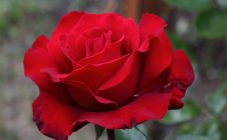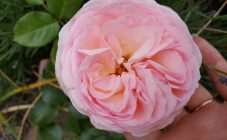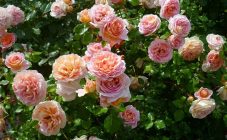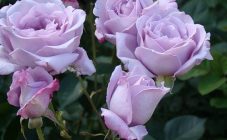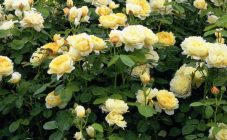Content:
Park rose variety John Davis was created by selection by scientists from Canada. It contains resilience from wild-growing brethren and refinement of noble specimens. Thanks to these qualities, the John Davis rose is popular with many summer residents.
Description
Canadian park varieties of roses are frost-resistant, do not require warming for the winter. Often, during severe frosts, aboveground buds freeze out, but with the arrival of spring they recover. This is one of the main advantages of this type.
John Davis hybrid variety. His parents are:
- wild rosehip;
- rose Rugosa.
Thanks to these two species, it turned out to be a gorgeous bush with long foliage falling down to the ground. John Davis rose grows up to 2 meters high. The presence of thorns is not numerous, the buds are large. Their diameter is about 8 cm. About 15 pieces are formed in a brush. Flowering begins in early June and continues throughout the summer. With the arrival of autumn, it finally stops. Terry flowers are quite large, very beautiful and have a weak fruity-spicy fragrance that is not persistent. The tips of the John Davis rose petals are usually pale pink, as if faded. The middle of the flower is bright pink. The flowers are fluffy with numerous petals. The disclosure is complete, the stamens are golden.
To give the shrub a shape, it must be tied up, since the rather spreading branches with lush foliage fall apart and give the bush a sloppy and unsightly look.
Gardeners who are engaged in the cultivation of this variety note that the flowering of the rosette ends quite quickly and in August the shrub almost fades away. And the aroma of buds on some plants is completely absent. To avoid this, you need to carefully follow all instructions for growing.
Rules for breeding and planting a park rose
The shrub can be propagated in several ways:
- cuttings;
- dividing the bush;
- with the help of offspring.
For reproduction in the first way, special preparation and diligence will be required. It happens as follows:
- At the beginning of July, the cutting is separated from the shrub by an oblique cut, preferably with two internodes.
- It is processed using Kornevin.
- A specialized greenhouse is being prepared.
- A landing site is organized:
- a small hole is dug;
- to the middle is filled with manure;
- closed with spandbond;
- left for 7 days to warm up;
- after the expiration of time, fertile soil is added, consisting of humus and peat in equal proportions;
- river sand is added on top.
- Cuttings are planted in the soil at least 2 cm deep.
- The seedlings are watered abundantly.
- Cover with foil.
- It is necessary to irrigate and ventilate every day.
- With the appearance of callus, not earlier than three weeks, the film is removed.
- In two weeks, the development of the root system will begin.
- The stalk remains in the greenhouse for the winter, and with the arrival of spring it is transplanted to open ground.
The second breeding method is carried out as follows:
- Before buds appear on the bush, it is dug up.
- All branches are cut off.
- The bush is divided into parts. There should be at least two buds on each division.
- The landing site is being prepared.
- A hole is being dug.
- Delenki are planted in the ground to a depth of at least 5 cm.
- Seedlings are watered abundantly throughout the period until bud break. Then the irrigation should be reduced to once a week. During the period of bud formation, watering should be resumed up to 2-3 times every 7 days.
- Periodically hilling, mulching and weeding.
Reproduction in the third way is the easiest of all. It happens like this:
- Rooted offspring are separated from the bush after a year.
- Further, all actions are carried out as in the first method.
When choosing a place for planting this variety, you should focus on the following nuances:
- Priming. The soil should be moderately acidic. To make the land fertile, it is necessary to add a variety of special compounds.
- Illumination. It is necessary to select a landing site in the semi-shady areas of the summer cottage.
- Watering. Should be regular and performed at least 1 time per week.
Care advice
In care, this variety, like other types of park roses, is not particularly whimsical. Periodically feed the plant. Its composition is as follows:
- 20 g of ammonium nitrate;
- 30 g superphosphates;
- 10 g potassium salt;
- 10 liters of water.
5 liters of top dressing must be poured under one shrub. Then water abundantly.
During the formation of buds, water no more than 3 liters per plant with a superphosphate solution:
- 10 liters of water;
- 30 g superphosphates.
With the beginning of bud formation and flowering, you need to take care of regular watering. It is recommended to make it in the evening. In a hotter period, increase the flow rate and watering time several times. It is advisable to moisten the soil up to half a meter. In the autumn period, watering as needed;
With the arrival of spring, it is necessary to remove dried and diseased branches.
Preparing for winter
Park rose variety John Davis does not need shelter for the winter period, as it is a frost-resistant plant and easily tolerates frost. It is only necessary to cover the root system with earth using hilling. But for personal reassurance, you can shelter young stepsons at the end of autumn for three years.
When the snow melts, the soil under the bush should be leveled and covered with peat at least 3 cm high.
Application in landscape
The John Davis rose variety is excellently used in landscape design. They are usually planted in the penumbra of conifers, junipers, in the form of compositions of four shrubs with various colors of buds. The creation of a beautiful appearance of the backyard territory is possible by planting together with such flowers as:
- daylily curly;
- subulate carnation;
- thrift;
- lupine;
- astilba;
- sage.
Planting around recreation sites, a summer kitchen or a gazebo will make an indelible impression on vacationers during the flowering period. Looking at the stunning beauty of roses while drinking your morning coffee or having breakfast will bring a lot of positive emotions for the whole day.
To create a rose garden, you should take care of the variety of varieties in advance, learn about their advantages, disadvantages, the nuances of growing and care.
The best place to create a rose garden would be the central part of the garden plot. Shrubs must be of the same height. Only around the rose garden can you plant hybrid tea dwarf varieties of roses, indicating the border. This will add a special piquancy to the planted area.
In the form of single plantations, John Davis roses also look quite attractive. They can be used as hedges or to indicate a border. Or you can make a backyard alley by landing along paths and paths.
By following all the recommendations, you can grow stunningly beautiful and well-groomed shrubs of the park rose of the John Davis variety with graceful large flowers and a fragrant aroma.







